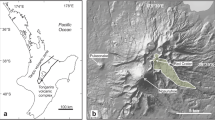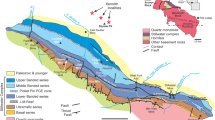Abstract
Tephra lapilli from six explosive eruptions between April 1996 and February 1998 at Popocatepetl volcano (=Popo) in central Mexico have been studied to investigate the causes of magma diversification in thick-crusted volcanic arcs. The tephra particles are sparsely porphyritic (≈5 vol%) magnesian andesites (SiO2=58–65 wt%; MgO=2.6–5.9 wt%) that contain phenocrysts of NiO-rich (up to 0.67 wt% NiO) magnesian olivine (Fo89–91 cores) with inclusions of Cr-spinel (cr#=59–70), orthopyroxene (mg#=63–76), clinopyroxene (mg#=68–86), intermediate to sodic plagioclase (An33–66), and traces of amphibole. Major and trace element systematics indicate magma mixing. The liquid mg#melt ratios inferred from the ferromagnesian phenocrysts suggest the existence of a mafic (mg#melt ≈ 72–76) and an evolved component magma (mg#melt ≈ 35–40). These component magmas form a hybrid magnesian andesite with an intermediate range of mg#melt=50–72. The mafic end member (mg#melt ≈ 72–75) is saturated with olivine and spinel and crystallizes at temperatures ≈1170–1085 °C with oxygen fugacities close to the fayalite–magnetite–quartz buffer and elevated water contents of several wt% H2O. A likely location of crystallization is at lower crustal levels, possibly at the Moho. Olivine is followed by high-mg# clinopyroxene which could start to crystallize during magma ascent. At depths of ≈4 to 13 km, the mafic magma mixes with an evolved composition containing low-mg# clino- and orthopyroxene and plagioclase at a temperature of ≈950 °C. The repetitive ascent of batches of mafic magmas spaced days to weeks apart implies multiple episodes of crystallization and magma mixing. The tephra is similar to the Popo magnesian andesites, suggesting similar generic processes for the common lavas of the volcano. The advantage of the tephra is that it can be used to reconstruct the composition of the mafic magma. Building on the elemental systematics of the tephra and a comparison to the near-primary basalts from the surrounding monogenetic fields, we infer that the Popo mafic end member is a magnesian andesite with variable, but high SiO2 contents of ≈55–62 wt% and near-primary characteristics, such as high-mg#melt of 72–75, FeO*/MgO ratios <1 (if extrapolated to an mg#melt of 72–75), and high Ni contents (=200 ppm Ni). This model implies that the typical elemental signature of the Popo andesites, such as the low CaO, Al2O3, FeO*, high Na2O contents, and the depletion in high-field strength elements (e.g., P, Zr, Ti), are mantle source phenomena. Thus, determining the elemental budget of the magnesian andesite, as it is prior to the modifications by crustal differentiation, is central to quantifying the subcrustal mass fluxes beneath Popo.
Similar content being viewed by others
Author information
Authors and Affiliations
Additional information
Received: 13 December 1999 / Accepted: 11 August 2000
Rights and permissions
About this article
Cite this article
Straub, S., Martin-Del Pozzo, A. The significance of phenocryst diversity in tephra from recent eruptions at Popocatepetl volcano (central Mexico). Contrib Mineral Petrol 140, 487–510 (2001). https://doi.org/10.1007/PL00007675
Published:
Issue Date:
DOI: https://doi.org/10.1007/PL00007675




